Disclosure: We may earn commissions if you purchase products after clicking on a link from our site.
Have you always wanted to experience the thrill of catching sailfish? Do you want to learn how to catch sailfish? Sailfish is one of the most challenging fishes to catch. They are of the billfish species of fish that also include swordfish, marlin, and spearfish. They are very large, powerful, and put up a spirited fight when hooked.
Sailfish are also very fast swimmers which makes it even more challenging when fishing for them. In this article, we discuss the fishing methods, tips, tricks tackle, bait, and other information to help you experience catching sailfish.

Table of Contents
How To Catch Sailfish
There are several fishing methods that work well when targeting sailfish. Most anglers will implement, trolling, kite fishing, drifting, or sight fishing.
1. Kite Fishing
Kite fishing is a specialized technique used primarily in calm conditions or areas with little to no current. Anglers deploy a kite from the boat, suspending multiple lines with live baits at various depths from the kite. The kite keeps the baits near the surface, mimicking the behavior of struggling or injured prey, which can attract sailfish from below.
Kite fishing allows anglers to cover a wide area while keeping baits in the strike zone for extended periods, increasing the likelihood of enticing a sailfish to strike. Once a sailfish takes the bait, the angler must quickly react to set the hook and commence the exciting battle that ensues.
2. Trolling
Trolling is one of the most popular and effective methods for catching sailfish. Anglers typically deploy multiple lines behind a moving boat, each rigged with artificial lures or natural baits such as ballyhoo or mullet. The boat’s movement simulates a school of baitfish, attracting the attention of sailfish as they hunt for prey.
Trolling allows anglers to cover large areas of water and explore different depths, increasing the chances of encountering sailfish. Once a sailfish strikes, the angler must quickly reel in the line to set the hook and initiate the thrilling battle that follows.
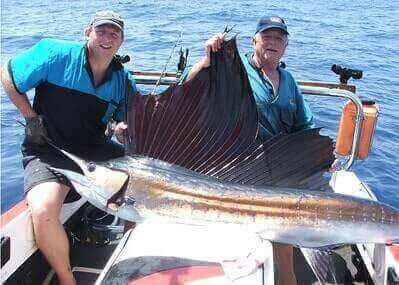
3. Sight Fishing
Sight fishing is another method used by anglers to catch sailfish. This method involves looking out for baitfish like ballyhoo frantically escaping from an area. The chances are that they are fleeing from a predator like sailfish and this is a sign for you to target that area with your bait and lures to catch sailfish.
4. Live Baiting
Live baiting involves deploying live fish, such as pilchards, mullets, or sardines, either on the surface or at varying depths to entice sailfish. Anglers typically rig the live baitfish with circle hooks or J-hooks to maximize hookups while minimizing harm to the fish.
Live baiting is often favored in areas where sailfish are known to feed actively, allowing anglers to present a natural and irresistible offering to these fast-swimming predators. Patience is key with live baiting, as anglers must wait for the sailfish to locate and strike the bait before setting the hook and engaging in the exhilarating fight.
5. Drifting With Baits
Drifting with baits involves deploying natural or artificial baits while allowing the boat to drift with the current or wind. This method is effective in areas with strong currents or when sailfish are actively feeding over a wide area. Anglers can deploy baits at varying depths using different rigs, such as flatlines, deep lines, or downriggers, to target sailfish at different water depths.
Drifting with baits allows anglers to cover a large area while presenting their offerings naturally and enticingly, increasing the chances of hooking into a sailfish. Once a sailfish takes the bait, anglers must quickly respond to set the hook and engage in the thrilling battle that follows.

Sailfish Tackle Setup
A 20- to 30-pound conventional or spinning fishing rod will work well when you fish for sailfish using kite fishing or trolling. If you are targeting sailfish on the surface, you can use a 12- to 20-pound spinning fishing rod.
The fishing reel has to match the rod and a 12- to 30-pound spinning or conventional reel will work when fishing for sailfish. You can use a 12- to 30-pound monofilament line and a 15-foot wind-on leader of 40- to 50-pound fluorocarbon. In-circle hooks, 4/0 to 7/0 will work depending on the size of the bait.
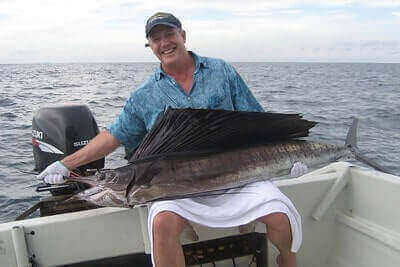
Sailfish Fishing Tips
- Always keep on the lookout for birds circling above the water exhibiting a specific behavior. Look for frigates that are cruising or diving and working the water. If you find birds circling or diving into the water, that is a sure sign that they are targeting fish.
2. Sailfish likes warm temperatures and this makes the water temperature important when fishing for sailfish. Learn to study the sea-surface temperatures, especially the morning weather conditions.
3. Sailfish often travel in groups. When you get one hooked, quickly get it off and set your line back in the water as there are others nearby that you can also get.
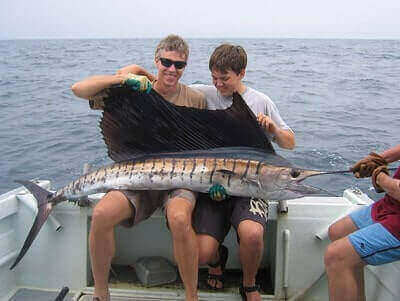
4. Set your hook sets low just in case you miss, the fly will be in position for another bite.
5. Prevent the fly line from wrapping around the rod’s tip when the sailfish jumps. Stick the tip in the water to increase tension on the line.
6. When fishing for sailfish, remember that they prefer hunting into the current.
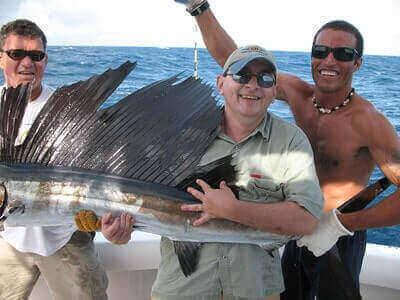
7. Always let the sailfish run for a few seconds before engaging the reel when using a circle hook. Do not jerk your rod tip upward. Instead, let the circle hook work and set it in the corner of the fish’s mouth.
8. Wear gloves when releasing the fish back into the water to protect your hand from the bill as well as protect the fish from damage.
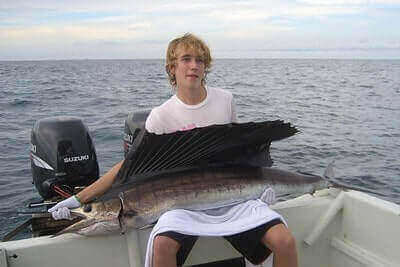
9. Try to not pull the sailfish out of the water. Just hold the bill and pull it through the water at a slow speed and release it back when it seems to have recovered from the catch.

Best Baits For Sailfish
1. Blue Runners
Blue runners (Caranx crysos) are a popular and effective bait choice for anglers targeting sailfish. These sleek and silver-colored fish closely resemble the natural prey of sailfish, making them irresistible to these apex predators. Blue runners are known for their strength and agility, making them ideal for enticing sailfish into striking.
Anglers typically rig blue runners using circle hooks or J-hooks to maximize hookups while minimizing harm to the baitfish. Blue runners can be deployed using various fishing methods, including trolling, live baiting, or kite fishing, depending on the angler’s preference and prevailing conditions.
When rigged and presented correctly, blue runners emit subtle vibrations and movements that closely mimic those of injured or distressed prey, enticing sailfish to strike with ferocity. Overall, blue runners stand as a reliable and highly effective bait choice for anglers seeking success in their pursuit of sailfish, offering both excitement and satisfaction on the water.
2. Cigar Minnows
Cigar minnows (Decapterus punctatus) are highly prized baitfish among anglers targeting sailfish due to their natural appearance and enticing swimming action. These slender, silver-colored fish closely resemble the preferred prey of sailfish, making them an irresistible choice for enticing these apex predators.
Cigar minnows are typically rigged using circle hooks or J-hooks to maximize hookups while ensuring the baitfish remains lively and natural in the water. Anglers often deploy cigar minnows using various fishing techniques, such as trolling, live baiting, or kite fishing, depending on the prevailing conditions and angler preference.
When presented correctly, cigar minnows emit subtle vibrations and movements that closely mimic those of injured or distressed prey, effectively enticing sailfish to strike with aggression. Their durability and availability make cigar minnows a popular and reliable bait choice for anglers seeking success in their pursuit of sailfish, offering both excitement and satisfaction on the water.
3. Goggle Eyes
Google eyes, also known as bullet bonito or small skipjack tuna, are a popular bait choice for anglers targeting sailfish. These small, streamlined fish closely resemble the natural prey of sailfish, making them highly effective at attracting these apex predators.
Google eyes are typically rigged using circle hooks or J-hooks to maximize hookups while ensuring the baitfish remains lively and natural in the water. Anglers often deploy Google Eyes using various fishing techniques, such as trolling, live baiting, or kite fishing, depending on the prevailing conditions and angler preference.
When presented correctly, google eyes emit subtle vibrations and movements that closely mimic those of injured or distressed prey, effectively enticing sailfish to strike with aggression. Their availability and ability to swim at varying depths make Google Eyes a reliable and versatile bait choice for anglers seeking success in their pursuit of sailfish, offering both excitement and satisfaction on the water.
4. Pilchards
Pilchards, also known as scaled sardines or whitebait, are a staple bait choice for anglers targeting sailfish. These small, silvery fish are highly prized for their natural appearance and enticing scent, closely resembling the preferred prey of sailfish. Pilchards are typically rigged using circle hooks or J-hooks to maximize hookups while ensuring the baitfish remains lively and natural in the water.
Anglers often deploy pilchards using various fishing techniques, such as trolling, live baiting, or kite fishing, depending on the prevailing conditions and angler preference. When presented correctly, pilchards emit subtle vibrations and movements that closely mimic those of injured or distressed prey, effectively enticing sailfish to strike with aggression.
Their abundance in many coastal waters and ability to swim near the surface make pilchards a reliable and versatile bait choice for anglers seeking success in their pursuit of sailfish, offering both excitement and satisfaction on the water.

5. Speedos
Speedos, also known as frigate mackerel or bullet mackerel, are a popular bait choice for anglers targeting sailfish. These slender and fast-swimming fish closely resemble the natural prey of sailfish, making them highly effective at attracting these apex predators.
Speedos are typically rigged using circle hooks or J-hooks to maximize hookups while ensuring the baitfish remains lively and natural in the water. Anglers often deploy speedos using various fishing techniques, such as trolling, live baiting, or kite fishing, depending on the prevailing conditions and angler preference.
When presented correctly, speedos emit subtle vibrations and movements that closely mimic those of injured or distressed prey, effectively enticing sailfish to strike with aggression. Their streamlined shape and ability to swim at varying depths make Speedos a reliable and versatile bait choice for anglers seeking success in their pursuit of sailfish, offering both excitement and satisfaction on the water.
6. Sardines
Sardines are a highly sought-after bait choice for anglers targeting sailfish due to their natural appearance and enticing scent. These small, silvery fish closely resemble the preferred prey of sailfish, making them incredibly effective at attracting these apex predators.
Sardines are typically rigged using circle hooks or J-hooks to maximize hookups while ensuring the baitfish remains lively and natural in the water. Anglers often deploy sardines using various fishing techniques, such as trolling, live baiting, or kite fishing, depending on the prevailing conditions and angler preference.
When presented correctly, sardines emit subtle vibrations and movements that closely mimic those of injured or distressed prey, effectively enticing sailfish to strike with aggression. Their abundance in many coastal waters and ability to swim near the surface make sardines a reliable and versatile bait choice for anglers seeking success in their pursuit of sailfish, offering both excitement and satisfaction on the water.
7. Mullet
Mullet, known for their robustness and strong scent, is a popular and effective bait choice for anglers targeting sailfish. These large, silver-colored fish closely resemble the natural prey of sailfish, making them highly appealing to these apex predators.
Anglers typically rig mullet using circle hooks or J-hooks to maximize hookups while ensuring the baitfish remains lively and natural in the water. Mullet can be deployed using various fishing techniques, including trolling, live baiting, or kite fishing, depending on the prevailing conditions and angler preference.
When presented correctly, mullets emit subtle vibrations and movements that closely mimic those of injured or distressed prey, effectively enticing sailfish to strike with aggression. Their durability and resilience in the water, along with their ability to swim at varying depths, make mullet a reliable and versatile bait choice for anglers seeking success in their pursuit of sailfish, offering both excitement and satisfaction on the water.
8. Threadfin Herring
Threadfin herring, prized for their slender bodies and shimmering scales, are an excellent bait choice for anglers targeting sailfish. These small, silvery fish closely resemble the preferred prey of sailfish, making them highly attractive to these apex predators.
Anglers typically rig threadfin herring using circle hooks or J-hooks to maximize hookups while ensuring the baitfish remains lively and natural in the water. Threadfin herring can be deployed using various fishing techniques, including trolling, live baiting, or kite fishing, depending on the prevailing conditions and angler preference.
When presented correctly, threadfin herring emit subtle vibrations and movements that closely mimic those of injured or distressed prey, effectively enticing sailfish to strike with aggression. Their availability in many coastal waters and ability to swim near the surface make threadfin herring a reliable and versatile bait choice for anglers seeking success in their pursuit of sailfish, offering both excitement and satisfaction on the water.
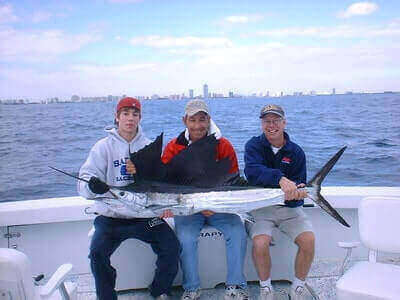
Best Lures For Sailfish
1. Spoons
Spoons are a popular and effective lure choice for anglers targeting sailfish. These metal lures feature a shiny, reflective surface that mimics the appearance of baitfish, making them highly attractive to sailfish hunting for prey.
Anglers typically deploy spoons using trolling techniques, trailing them behind a moving boat to cover large areas of water and mimic the movement of a school of baitfish. The fluttering action and flash of a spoon in the water can trigger the predatory instincts of sailfish, enticing them to strike with aggression. Anglers can vary the speed and depth of the spoon presentation to experiment with different tactics and increase their chances of success.
When a sailfish strikes a spoon, the angler must quickly react to set the hook and engage in the exhilarating battle that follows. Overall, spoons stand as a reliable and versatile lure choice for anglers seeking excitement and satisfaction in their pursuit of sailfish, offering both effectiveness and versatility on the water.
2. Feathers
Feathers are a classic and effective lure choice for anglers targeting sailfish. These lures typically consist of multiple colorful feathers or synthetic materials tied together to create a lifelike baitfish imitation. The vibrant colors and fluttering action of feathers closely mimic the movement of small baitfish, making them irresistible to sailfish.
Anglers often deploy feather lures using trolling techniques, trailing them behind a moving boat to cover large areas of water and mimic the behavior of a school of baitfish. The erratic movement and enticing presentation of feather lures can trigger the predatory instincts of sailfish, enticing them to strike with aggression.
Anglers can vary the speed and depth of the lure presentation to experiment with different tactics and increase their chances of success. When a sailfish strikes a feather lure, the angler must quickly react to set the hook and engage in the thrilling battle that ensues. Overall, feathers stand as a time-tested and versatile lure choice for anglers seeking excitement and satisfaction in their pursuit of sailfish, offering both effectiveness and versatility on the water.
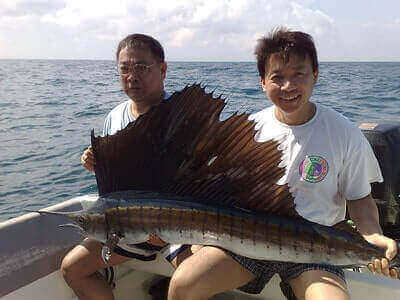
The Bottom Line
Sailfish is a large and powerful fish that anglers like to target as it is an exciting sports fish. It is a member of the billfish species and can be found on the Eastern coast of the United States and Canada as well as in the Gulf of Mexico.
It is a challenging fish to catch as it is not only large and powerful, but it is very fast and will put up a spirited fight when hooked. In this article, we discussed how to catch sailfish, discussed the fishing methods for sailfish, the best baits and lures, and other information about sailfish. If you also fish for marlin, you can also read how to catch marlin and how to catch swordfish.